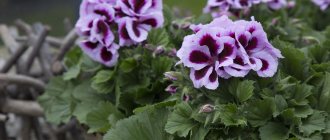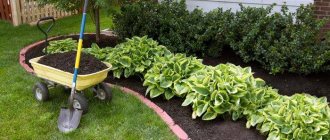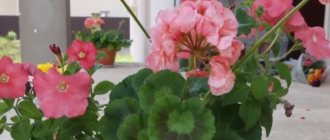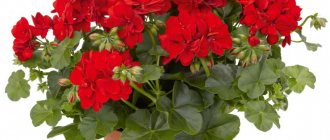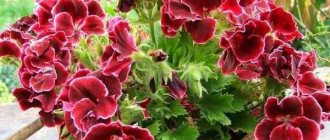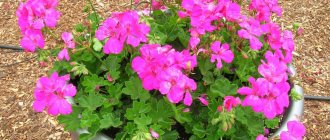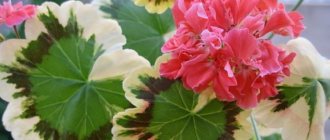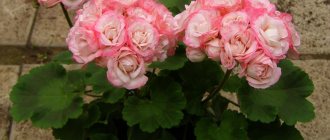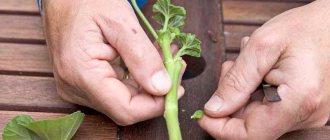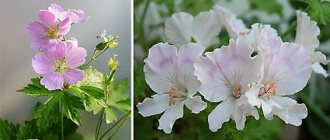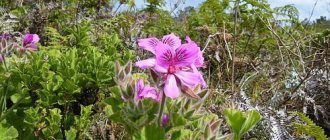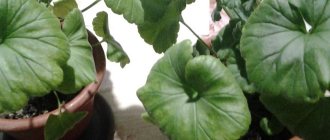Over the past decades, domestic breeders have managed to develop various varieties that are maximally adapted to our climatic conditions.
Today, ampelous ivy-leaved pelargonium is a common indoor flower that delights with beautiful inflorescences and a pleasant aroma.
Differences from ordinary geranium
Very often, ivy-leaved pelargonium is mistakenly called geranium ; on many sites you will find the use of these two names as synonyms. Initially, confusion arose due to incorrect attempts by scientists to classify the plant back in the 17th century. To fully appreciate the differences between two different flowers, it is worth considering the signs that indicate this:
Geranium ivy is a low plant with an erect base. Pelargonium is a decorative creeping subshrub, the shoots of which grow up to a meter in length.
- Ivy geranium leaves are delicate and soft to the touch, while pelargonium leaves are characterized by glossy surfaces and five-lobed shapes.
- The bright red inflorescences of indoor plants are very decorative, which is why they have won the sympathy of gardeners. Common geraniums have symmetrical blue flowers.
- Being native to the southern hemisphere, many varieties of pelargonium are heat-loving and suitable for growing exclusively indoors. And geraniums can also be planted in gardens, because... its homeland is northern latitudes and it can withstand cold temperatures
Application in landscape design
Ivy-leaved pelargonium deserves a special place in garden and indoor landscaping. Its hardiness, low watering requirements and ability to withstand direct sunlight make it an ideal plant for vertical gardening in containers and flowerpots. Strong shoots will not be broken by the wind in balcony compositions, and the ability to weave along the support allows them to be used for small trellises. It looks great indoors all year round and retains its green leaf mass in winter.
How to arrange geranium-pelargonium in the garden plot
Why do professional designers create the most beautiful gardens? The fact is that they think through the design project in advance and use various decorations for the garden. To make you proud of your suburban area at all times of the year, consider a set of plants that will bloom at different times. Decoration is also very important, let's see how you can decorate a geranium.
How to incorporate geranium into landscape design:
- Ivy geranium is distinguished by its creeping nature. This is a flower that will look great on alpine slides and gazebos. Another interesting technique is when a clay jug is placed on its side in the garden, and creeping pelargonium is planted next to it. Thus, it seems that beautiful flowers have poured out of the jug.
- Rose geranium is incredibly beautiful. It can be placed in a decorative wooden cart. It will seem that the florist is bringing his harvest for sale.
- You can plant creeping forms of plants on the balcony. In this case, the plant will entwine its frame, and from the street it will look amazing.
To create a landscape design for your garden, you can collect ideas from all over the world. In this case, you will be able to create a unique design on your site or window that will amaze everyone with its beauty.
Geranium is a plant that blooms with beautiful fragrant flowers. You can and should plant it in your suburban area, but you need to know how to do it correctly. In this case, you will get a chic landscape design.
Video tips from landscape designers
Popular varieties
Varieties worth paying attention to:
- AMETHYST . An excellent option for a veranda or balcony. After planting, the plant develops quickly, resulting in the formation of a decorative “living” basket. Inflorescences of large double flowers are characterized by dark pink, purple, and bright crimson shades.
- CROCODILE . A characteristic feature is the original color of the leaves: bright yellow veins are clearly visible on a green background. Inflorescences are formed from coral or purple flowers.
- JAGKY GAULD . The subshrub develops quite quickly and is characterized by lushness and branching. Initially, double flowers are snow-white in color, but under the influence of ultraviolet radiation they can turn purple or pink.
- ICEROSE . An adult shrub is completely covered with double white flowers. Externally, the plant somewhat resembles a rose bush.
- ROULETTA . The low shrub is characterized by its abundance. The highlight of the variety is the original color of the flowers: the white petals along the edges are painted bright pink.
- MRS. MARTIN . The variety develops very quickly; an adult plant forms a decorative “living” basket. The inflorescences consist of double flowers of a light lilac or pink hue.
- RHAPSODY . The variety is a lush shrub with glossy leaves and burgundy inflorescences.
ADVICE ! Almost all varieties of ampelous pelargonium develop very quickly. It only takes a few weeks to grow a lush bush, while the rhizome fully performs its functions even in cramped containers. Ivy-leaved pelargonium sheds its leaves and flowers if the root system still lacks space.
Description of ampelous pelargonium (with photo)
Let's start the description with the fact that only a few species with long hanging stems can be grown as an ampelous plant. The shoots are most often long, can reach 70-100 cm. In many varieties, the stems have the ability to curl and climb supports, so the plant is often used to decorate small vertical structures and walls in the room.
During the flowering period, pelargonium readily forms umbrella inflorescences that collect a variety of flowers. There are varieties with double, star-shaped, cactus-shaped, peony-shaped and simple buds. The diameter of the apical inflorescence often exceeds 8-10 cm. One “umbrella” can contain up to 30-50 flowers on long flower stalks. Pelargonium boasts a very wide variety of colors of inflorescences. They can be purple, white, red, pink, lilac, white and other colors.
There are varieties with two or three colors, most often this is a contrasting border of the corolla petals, as shown in the photo of ampelous pelargonium below:
How to plant and propagate
Pelargonium can be propagated in two ways: seeds and cuttings . The first method is more painstaking and is used only by experienced gardeners. For convenience, the planting process should be divided into several stages:
- Seed preparation . Large pelargonium seeds are protected by a thick shell, so before planting them in the ground, it is recommended to carry out scarification using a sharp object or sandpaper. Under no circumstances should the inner seed be damaged.
- Soil preparation . The easiest option is to use a store-bought compound. If you are used to doing everything yourself, you need to mix three main ingredients, taken in equal proportions: turf soil, sand, peat.
Direct landing . First, the ground is watered abundantly with a spray bottle. The depth of planting seeds in the soil should not exceed 0.5-1 cm. Containers with future vegetation are covered with a transparent film and placed in a place with temperatures of +22-25°C.
- Watering and further care . The soil with seeds is watered once every 5-6 days. For ventilation, periodically open the film for several hours.
ADVICE! After scarification, it is advisable to treat the soil and sorted seeds with a solution of potassium permanganate.
How to root pelargonium? Here are step-by-step instructions for propagation by cuttings:
- the best period for this is the beginning of spring;
- In order for pelargonium to reproduce well, only large and healthy shoots are selected, cut and dried for 24 hours;
- the plants are transplanted to a permanent place after a month.
Reproduction of ampelous pelargonium
Ampelous pelargonium or geranium does not differ from other species in any complex methods of reproduction. Just like other varieties, new specimens can be obtained using seeds or by cuttings.
For large group plantings of flowers, it is best to use seed propagation. At the moment, there are many different hybrids and botanical varieties that differ in the length of the stems, purpose, color and shape of the buds. As well as mixtures of planting materials that allow you to grow several plants with a variety of flowers, but similar in leaf shape.
You can sow planting material for propagation of ampelous pelargonium from mid-winter, if you can provide additional illumination with fluorescent lamps for the seedlings. The sowing time can be extended until the end of April. If you sow the plant at this time, the perennial will begin to bloom in early summer. Use shallow containers as containers. They need to be filled with a peat-based nutrient substrate. Before planting the seeds, the soil is moistened. Planting material is planted to a depth of 4-5 mm. After sowing, cover the container with the seeds with a transparent cap made of polyethylene or glass.
Soil preparation
As mentioned above, in order for the flowers to take root successfully, it is enough to buy universal soil in the store . But you can prepare it yourself.
Ingredients you will need to prepare your own soil:
- turf land;
- leaf soil;
- humus;
- peat;
- sand.
The proportions of the components must be equal. A small pot can be used as a pot.
Growing conditions
For good growth and rich flowering, it is necessary to create the right conditions and provide appropriate care. Ivy-leaved pelargonium at home requires nutritious soil, sufficient lighting, and a certain temperature regime.
Lighting and temperature conditions
Ampelous species of pelargonium need very bright light, but they can be exposed to the full sun and not worry that they will get burned - this will not happen. But on the north side, these flowers will not feel so great - although they will not die, the flowering will not be so bright and abundant. The fact is that they require a fairly long daylight hours, so in winter you will have to additionally illuminate such a plant.
As for the temperature regime, pelargonium loves a warm climate, so in summer a temperature of +25-28 degrees is suitable for it. Geranium will survive higher rates, but additional moisture will be required. In winter, it is necessary to maintain a temperature of +15, for her this is the optimal indicator at which she can even set buds.
Watering and air humidity
Pelargonium is not afraid even of excessively dry air, and it is completely neutral about spraying, but in dry times it will need daily watering. But you need to take into account that geranium foliage is not adapted to excessive humidity, so the accumulation of moisture on it can cause rotting. In this regard, when watering, it is necessary to apply water exclusively to the roots, and not to irrigate the entire flower.
At home, when caring for ivy-shaped pelargonium, the main thing is not to overdo it in watering. Excess moisture is simply destructive for this flower, so it is better not to water it too much than to overwater it. In hot weather, it needs frequent watering, but this should be done in small doses. And it’s better to check the soil first: if at a depth of 2-3 centimeters it is still wet, then you should wait until watering. And in winter, geraniums are watered no more than once a week.
Replanting and fertilizing
Experienced pelargonium breeders recommend not to carry out replanting work too often; for a young flower, one replant every 2-3 years will be enough, for an older plant once every 5 years. When choosing a new flowerpot, it is necessary to take into account that it should be 3-5 centimeters wider than the previous one, and 5 higher.
If the flowerpot was initially large, then you should not change it, but carry out a partial replanting; for this you just need to update the top layer of soil, with the obligatory addition of the necessary fertilizers. When removing a flower from an old flowerpot, you need to carefully grab the flower by the base and, holding the roots, transfer it to a new container. All this must be done with extreme caution so that the stems and roots of pelargonium are not damaged. Only in this case the flower will quickly adapt and take root in the new soil and pot.
As for the soil, it should be very loose and nutritious. If the substrate is made independently, then it must include:
- river sand;
- garden humus;
- leaf turf;
- peat.
This composition perfectly retains moisture in the soil, but also does not allow it to stagnate there for a long time, so rotting of the roots will not occur. A good drainage layer must be laid at the bottom; it will save the plant from excess moisture. For this hanging crop, it is better to take hanging pots, although ordinary ones can also be used.
Fertilizing is applied between May and August. The fact is that at this time the flowering period of pelargonium begins, so it needs to be thoroughly fertilized, this is done weekly. Purchased products intended for flowering garden crops are best suited for this. The rest of the time, fertilizing is done much less frequently; it is enough to feed the flower once a month or every month and a half. In spring and autumn, potassium or phosphorus compounds are suitable for them, and in winter it is better to add organic fertilizers.
By the way, many flower growers use ordinary fresh milk as a fertilizer, which is diluted with water in a ratio of 1:2; this fertilizing strengthens the leaves of pelargonium and saturates the flower with the necessary substances.
Pruning and shaping the bush
To make the flower full and thick, annual pruning is required; it is best to carry out such an event in the first month of spring, as soon as the flower comes out of hibernation. On the bush, first of all, all old and dry stems are removed. Then, it is necessary to remove the remaining shoots that lack buds.
All pruning is done exclusively with a knife or scissors; tearing or breaking stems is strictly prohibited, since torn stems can rot and thereby harm the hanging plant. Tools used for pruning must be disinfected in advance. And after trimming, you need to treat the cut areas - crushed charcoal or regular activated charcoal in tablets is suitable for this.
All these measures will not only make the flower attractive, but will also rid it of weak and diseased shoots that prevent the flower from developing fully.
Complementary feeding and transplantation
The hanging plant needs feeding only in the spring-summer period , namely nitrogen fertilizers after winter dormancy and pruning to restore the volume of the green crown and compositions containing large amounts of potassium and phosphorus for vigorous flowering. The frequency of feeding is once every 10 days. In autumn and winter, the flower does not require additional organic and mineral nutrition.
Ivy-leaved pelargonium is replanted in the spring.
To make rooting more successful, a number of simple procedures are performed:
- the flower is removed from the old container along with a lump of soil on the rhizome, only those layers of soil that are easily removed are removed;
- the roots are partially removed - only the part that has grown into the drainage;
- The pots are thoroughly washed, the plant is placed in it, and new soil is added.
Advice! Dwarf varieties of ivy-leaved pelargonium are replanted every year or every other year.
How to plant a plant in the garden
It is best to plant the plant in open ground when the soil is well warmed up. At this time, the air is usually well warmed up, and the frosts have stopped.
If a pot is selected for growing a plant, then you need to know the capacity of the pot. You should not take containers with too large a volume. It should maximally exceed the volume of pelargonium roots by one and a half centimeters around the perimeter. The bottom of the pot should be lined with brick or pebble drainage.
After this, you need to prepare an earthen mixture, which consists of turf, sand, peat and humus. Half of the substrate needs to be poured into the pot, the bush should be lowered, and then the soil should be poured into the voids. The earth should not be compacted too much. After this, the bush is watered so that water does not get on its leaves. You can simply spray the soil with a spray bottle. If ivy-leaved pelargonium is planted in a garden bed, then you need to make several holes with an interval of at least 20 centimeters. The planting material goes deep into them no more than two centimeters. This way, root shoots will form faster.
Currently reading:
- Planting to decorate the site with three types of coniferous trees
- Choosing cucumbers for open ground according to your preferences
- Varieties, planting and care of perennial rudbeckia
- Exquisite juncus (rumen) spiral-shaped in the interior
Share the news on social networks
About the author: Vladimir Petrovich Efremov
Chief agronomist of the limited liability company “Association of Peasant (Farm) Farms “Kuznetsovskaya””, Ilovlinsky district of the Volgograd region.
Home care
Unlike many decorative indoor plants, pelargonium does not require painstaking care, which is why it has won the sympathy of gardeners. But still, in order for the flower to fully develop and please the eye, it is important to adhere to certain nuances:
- the ampelous representative of the Geraniaceae is a light-loving plant , so it is advisable to place flower pots on the south side;
- the optimal temperature in summer is +22-25°C, in winter, when pelargonium goes into a dormant state – +15°C;
- the plant practically does not suffer from drought, but excessive humidity can have a detrimental effect on development ;
- The recommended frequency of watering is once every 10-14 days; for this it is better to use a spray bottle .
Wintering conditions for outdoor hanging pelargoniums
To ensure that outdoor pelargonium does not turn into an annual, you need to know about the conditions for its storage during wintering. The tropical beauty cannot tolerate temperatures dropping below 10 degrees. In regions with cold winters and even in the European part, the perennial quickly freezes and dies even from short-term exposure to sub-zero temperatures. Also, you should not transfer to the winter and grow in normal home conditions those geraniums that are outdoors. In this case, the plant will experience severe stress and may get sick.
For wintering ivy-leaved ampelous pelargonium, choose a cool room with good lighting. Even at this time of year, geranium loves bright light. The air temperature in the room should be in the range of 10-12 degrees Celsius. If you keep a perennial in a pot, water the soil occasionally so that it does not dry out completely and cause the roots to die.
Some gardeners cut off the entire above-ground part of the perennial for the winter. Then, remove it from the pot and place it in a transparent plastic bag with damp moss. In it, the plant is stored throughout the winter months. The rhizome in sphagnum is periodically inspected, ventilated and moistened so that it does not die from drought.
With this method of overwintering the plant, a threat may arise that is directly related to various rodents. Mice can get into plants and eat not only the shoots, but also damage the rhizomes. Protect perennials from rodents. If it is not possible to create the necessary wintering conditions for geranium, then cut cuttings from the mother plants and propagate the perennial in this way, preserving all the characteristics of the mother bush.
How to prune ivy-leaved pelargonium
Ampelous pelargonium needs significant pruning for the purpose of rejuvenation . On the eve of winter, only the two lower leaves with axillary shoots are left, otherwise the stem will become completely bare, taking on an unsightly appearance.
In spring, bare branches and stems are trimmed, leaving the healthiest and youngest parts . To preserve the decorative appearance of plants, they promptly remove dried leaves and wilted inflorescences, and get rid of old woody shoots. It is recommended to resort to cuttings every 2-3 years.
This video explains in detail how to form a lush pelargonium bush by pruning:
Distinctive features, advantages and disadvantages
The difference between the ivy-leaved ampelous geranium and the usual one is that it forms hanging shoots up to 1 meter long.
The advantage of this species is its long flowering, which lasts all summer, and in some varieties until the end of autumn. The flowers are large, lush, and appear in large numbers.
Features of an adult plant:
- Buds . Bright, large and lush.
- Leaves . Original five-fingered shape, smooth, with a glossy shine.
- Stems . Hanging, thinner than ordinary geraniums.
- Escapes . They grow from the main stem and give the bush a lush appearance.
The flowers of the ampelous variety vary in size, shape and color. Variegated varieties look unusual: they are beautiful not only during flowering.
Another advantage of the plant is its unpretentiousness. Caring for ivy-leaved geraniums is no more difficult than caring for ordinary ones.
This variety has only one drawback: it does not tolerate winter well in conditions of lack of light. There are two options:
- arrange a cool winter;
- organize additional illumination with ultraviolet devices.
Possible diseases
Common problems that may affect indoor plants:
- fungal disease manifested by spotting on leaves;
- root rot, which is a consequence of excess moisture;
- a bacterial disease causes the plant to wilt;
- rust on leaves, usually characterized by yellow spots.
To prevent the further development of a particular disease, it is necessary to normalize care; in some cases, it will be necessary to resort to treating pelargonium with special means.
Ampelous ivy-leaved pelargonium can become a real decoration for your home, balcony, or garden plot, if you follow simple care rules.
